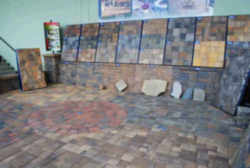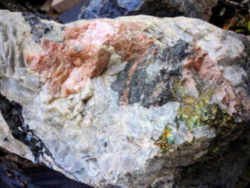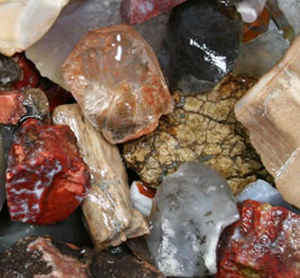
Massachusetts Symbols
Massachusetts State Building and
Monument Stone
Granite

Adopted in 1983.
Granite was made the building rock of the State in 1983. The last Ice Age did leave Massachusetts with exceptionally fine samples of this rock; granite from Quincy was used to build the Washington Monument.
Granite is used as dimension stone for walls and floors and countertops, a structural stone in foundations, and a monumental stone for grave markers, monuments, columns, sculpture and similar elements. It is also crushed for use as road metal, gravel and other applications of aggregate. Massachusetts is specific in honoring granite as a "building rock and monument stone," but in fact this is to differentiate granite from the state's official rock (Roxbury puddingstone), historical rock (Plymouth Rock), explorer rock (Dighton Rock) and glacial rock (Rolling Rock).
Among the most popular, the hardest, and the oldest of geosymbols, granite is an official symbol of New Hampshire, Massachusetts, North Carolina, South Carolina, Vermont, and Wisconsin.
Massachusetts Building and
Monument Stone:
Granite

The word granite comes from the Latin granum, a grain, in reference to the grained structure of such a crystalline rock
Granite is an igneous stone, one that is produced by intense heat. Granite is formed from liquid magma deep beneath the earth. Extreme pressures and a slow cooling process bake granite into one of the hardest and densest stones on the planet.
Granite occurs as stock-like masses and as batholiths often associated with mountain ranges and frequently of great extent. Granite has been intruded into the crust of the Earth during all geologic periods, except perhaps the most recent; much of it is of Precambrian age. Granite is widely distributed throughout the Earth.
The chief minerals of which granites are formed are feldspars and quartz and smaller amounts of mica and hornblende. They are classified as fine-grained,
medium-grained, or coarse-grained. Medium-grained granites are those in which the feldspar crystals average about ¼ inch (6mm) in diameter. If relatively
coarse-grained crystals appear in a fine grained groundmass the rock is designated as porphyritic granite. A rock may have the mineral constituents
of granite but may show a banded or platy structure owing to recrystallization, folding, or other changes while the rock was in a plastic or semi-molten
condition. Such metamorphic rocks are called granite gneisses.
Because of its hardness and comparative cheapness in relation to marble, granite is often used to make kitchen countertops. A granite countertop can be cut in any shape, and it is virtually unscratchable. Very hot pots must not be placed onto it though, because the temperature differential could possibly crack the granite
The Rock - GRANITE
Granite is a light-colored igneous rock with grains large enough to be visible with the unaided eye. It forms from the slow crystallization of magma below Earth's surface. Granite is composed mainly of quartz and feldspar with minor amounts of mica, amphiboles and other minerals. This mineral composition usually gives granite a red, pink, gray or white color with dark mineral grains visible throughout the rock.
- Igneous Rock Type: Intrusive
- Related to: Rhyolite, pegmatite, syenite
- Chemistry: Acidic
- Color: White, pink, orange, gray, black
- Texture: Phaneritic (easy to see crystals)
- Origins: Orogenic Plutons
- Common Minerals: Quartz, feldspars, hornblende and micas
- Accessory Minerals: Tourmaline, phosphates, rare earth oxides, beryl, topaz, zircons, augite, sphene and apatite
- Uses: Building material, decorative counter tops, tiles, tombstones, roads, jewelry, curling stones, marbles
Massachusetts Law
The law designating the granite as the official Massachusetts state building and monument stone is found in the General Laws of Massachusetts, Part 1, Title 1, Chapter 2, Section 25
PART I ADMINISTRATION OF THE GOVERNMENT
TITLE I JURISDICTION AND EMBLEMS OF THE COMMONWEALTH, THE GENERAL COURT, STATUTES AND PUBLIC DOCUMENTS
CHAPTER 2 ARMS, GREAT SEAL AND OTHER EMBLEMS OF THE COMMONWEALTH
Section 25 Building and monument stone of commonwealth
Section 25. Granite shall be the building and monument stone of the commonwealth.
Minerals, & Gems

Gemstone, Minerals, Rocks






